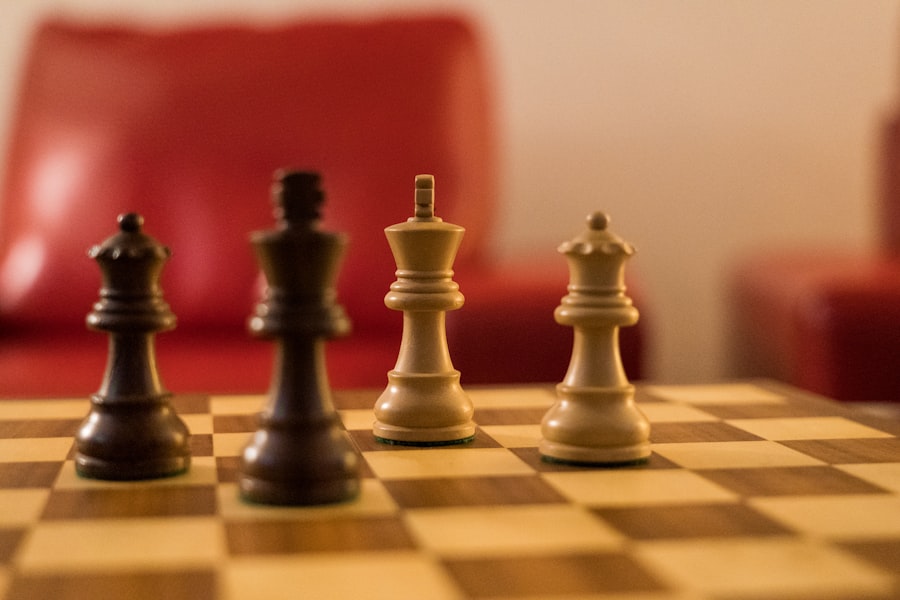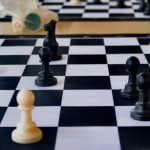Mastering Chess: Strategies for Success
Description
Chess is a game steeped in history, strategy, and intellectual challenge. At its core, chess is played on an 8×8 board, where two players command an army of 16 pieces each, including one king, one queen, two rooks, two knights, two bishops, and eight pawns.
Each piece has its own unique movement rules: for instance, rooks move in straight lines across rows and columns, while bishops glide diagonally. The queen is the most powerful piece, capable of moving in any direction, while the king can only move one square at a time. Understanding the basic rules and movements of the pieces is essential for any aspiring chess player.
However, chess is not merely about knowing how the pieces move; it also involves grasping fundamental concepts such as control of the center, piece development, and king safety. Controlling the center of the board allows players to maneuver their pieces more effectively and exert influence over the game. Developing pieces—moving them from their starting positions to more active squares—ensures that they are ready to participate in the battle.
Additionally, safeguarding the king through castling or creating a solid pawn structure is crucial for long-term success.
Key Takeaways
- Understanding the basics of chess is crucial for building a strong foundation in the game.
- Developing a strong opening strategy can give you an early advantage and set the tone for the rest of the game.
- Mastering the middle game requires strategic thinking and the ability to adapt to changing board positions.
- Creating a winning endgame plan involves consolidating your advantages and capitalizing on your opponent’s weaknesses.
- Utilizing tactical and positional play can help you control the board and outmaneuver your opponent.
Developing a Strong Opening Strategy
A well-crafted opening strategy sets the tone for the entire game. The opening phase of chess is characterized by piece development and establishing control over the center. Players often rely on established opening principles such as controlling the center with pawns and pieces, developing knights before bishops, and ensuring king safety through castling.
For example, the popular Italian Game begins with 1.e4 e5 2.Nf3 Nc6 3.Bc4, where White aims to control the center while preparing for rapid piece development. In addition to following general principles, players can also study specific opening systems that suit their style of play. The Sicilian Defense, for instance, is a counter-attacking opening that allows Black to challenge White’s central control while creating asymmetrical pawn structures.
This opening often leads to complex and dynamic positions that can favor players who thrive in tactical battles. Conversely, openings like the Queen’s Gambit offer a more strategic approach, focusing on solid pawn structures and long-term positional advantages. By familiarizing themselves with various openings and their underlying ideas, players can develop a repertoire that enhances their overall game.
Mastering the Middle Game

The middle game is where the true essence of chess unfolds. It is a phase characterized by tactical skirmishes and strategic maneuvering as players seek to capitalize on their opening advantages or recover from early setbacks. Mastering this stage requires a deep understanding of tactics—short-term combinations that can lead to material gain or checkmate—and strategy—long-term plans that dictate piece placement and pawn structure. Tactical awareness is crucial during the middle game. Players must be vigilant for opportunities to execute forks, pins, skewers, and discovered attacks.
For example, a knight fork can simultaneously attack two pieces, forcing the opponent to choose which one to save. On the strategic front, players should focus on improving their piece activity while restricting their opponent’s options. This might involve doubling rooks on an open file or creating weaknesses in the opponent’s pawn structure that can be exploited later.
The middle game is often where games are won or lost; thus, honing one’s skills in this phase can significantly impact overall performance.
Creating a Winning Endgame Plan
| Endgame Plan | Metrics |
|---|---|
| Number of Pieces | 8 |
| Controlled Squares | 15 |
| Passed Pawns | 2 |
| King Activity | High |
The endgame is the final phase of a chess match where fewer pieces remain on the board, and players must rely on precise calculation and technique to convert advantages into victory. Understanding key endgame principles is essential for success in this stage. One fundamental concept is the importance of king activity; in many endgames, the king becomes a powerful piece that can help support pawns in their journey toward promotion.
Players should also familiarize themselves with common endgame scenarios such as king and pawn versus king, rook endgames, and minor piece endgames. For instance, in a king and pawn endgame, knowing how to create a passed pawn—one that cannot be blocked by opposing pawns—can be decisive. Additionally, players should practice converting material advantages into wins; for example, if one side has an extra pawn in an endgame scenario, they must learn how to use that advantage effectively while avoiding stalemate traps.
Utilizing Tactical and Positional Play
Chess is a delicate balance between tactical prowess and positional understanding. Tactical play involves short-term calculations that can lead to immediate gains or threats against the opponent’s position. This includes recognizing patterns such as double attacks or discovered checks that can turn the tide of a game in an instant.
For example, a well-timed sacrifice can open up lines against the enemy king or win material by exploiting tactical vulnerabilities. On the other hand, positional play focuses on long-term advantages that may not yield immediate results but contribute to a stronger overall position. This includes concepts such as pawn structure, piece coordination, and control of key squares.
A player might choose to maintain a strong pawn chain while gradually improving their pieces’ positions rather than launching an immediate attack. Understanding when to switch between tactical and positional play is crucial; sometimes a tactical opportunity arises from a well-structured position, while at other times it may be necessary to sacrifice material for long-term positional benefits.
Improving Your Calculation and Visualization Skills

Calculation and visualization are critical skills for any chess player aiming to elevate their game. Calculation involves mentally analyzing potential moves and their consequences several moves ahead. This skill allows players to foresee threats and opportunities while evaluating different lines of play.
Practicing calculation can be done through tactics puzzles or by analyzing complex positions from actual games. Visualization complements calculation by enabling players to picture positions in their minds without moving pieces on a board. Strong visualization skills allow players to anticipate future positions based on current moves and assess potential outcomes more effectively.
Techniques such as blindfold chess—playing without sight of the board—can significantly enhance these skills over time. By regularly engaging in exercises that challenge both calculation and visualization abilities, players can develop a sharper instinct for recognizing patterns and making informed decisions during games.
Learning from Grandmasters and Chess Legends
One of the most effective ways to improve at chess is by studying the games of grandmasters and legendary players throughout history. Analyzing their games provides insight into advanced strategies, tactical motifs, and innovative ideas that can inspire one’s own play. Players like Garry Kasparov, Bobby Fischer, and Anatoly Karpov have left behind a wealth of games that showcase different styles and approaches to chess.
For instance, studying Fischer’s games reveals his aggressive style and deep understanding of openings, while Karpov’s games often highlight his positional mastery and ability to exploit small advantages over time. By reviewing annotated games or instructional videos featuring these legends, players can gain valuable lessons about decision-making processes during critical moments in a match. Additionally, many grandmasters have published books detailing their thought processes during games; these resources can serve as invaluable tools for aspiring players seeking to deepen their understanding of chess.
Practicing and Analyzing Games for Improvement
Regular practice is essential for any chess player looking to improve their skills. Engaging in online platforms or local clubs provides opportunities for playing against opponents of varying skill levels. However, simply playing games is not enough; analyzing those games afterward is crucial for identifying mistakes and areas for improvement.
Many players utilize software tools or databases to review their games alongside engine evaluations or master-level games. During analysis sessions, players should focus on critical moments where they made suboptimal moves or failed to capitalize on opportunities.
Additionally, keeping a chess journal can be beneficial; documenting thoughts on specific positions or strategies encountered during play can lead to deeper insights over time. By combining consistent practice with thorough analysis of both personal games and those of others, players can foster continuous growth in their chess journey.
FAQs
What is chess?
Chess is a two-player strategy board game that is played on an 8×8 grid. It is one of the most popular and enduring games in the world, with a rich history dating back over a thousand years.
How is chess played?
Chess is played on a square board divided into 64 squares, with each player starting with 16 pieces: one king, one queen, two rooks, two knights, two bishops, and eight pawns. The objective of the game is to checkmate the opponent’s king, which means putting the king into a position where it cannot escape capture.
What are the basic rules of chess?
Each type of chess piece moves in a specific way: the king moves one square in any direction, the queen moves any number of squares in any direction, the rook moves any number of squares horizontally or vertically, the bishop moves any number of squares diagonally, the knight moves in an L-shape, and the pawn moves forward one square and captures diagonally. The game ends when a player’s king is in checkmate, or when a stalemate is reached.
What are the benefits of playing chess?
Chess has been shown to have numerous cognitive benefits, including improving memory, concentration, problem-solving skills, and strategic thinking. It is also a great way to improve patience and decision-making abilities.
What is the history of chess?
Chess originated in India around the 6th century and spread to Persia, where it became known as “shatranj.” It then spread to the Arab world and Europe, evolving into the modern game of chess that we know today. Chess has a rich and storied history, with many famous players and memorable games throughout the centuries.





